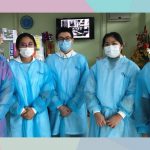From as early as I could remember, neuroscience has always been my field of passion and interest. In the final year of my Biomedical Science degree at the International Medical University, I was given the opportunity to take a step closer to achieving my dreams, with the chance to do a 3-month internship at any research institute of my preference. I applied to the Centre for Prions and Protein Folding Diseases at the University of Alberta in Canada, and am truly grateful to my principal investigator, A/Prof Holger Wille for accepting me. This centre consists of several laboratories and is located in the Brain and Aging Research Building of the University.
| The Project I was Working on |
|---|
| During my internship at this lab, I was assigned under Dr Xinli Tang, an experienced research associate and a wonderful person who guided me patiently throughout my time there. I worked on a project that aimed to produce monoclonal antibodies (mAbs) against prion proteins in vitro. Prion diseases are a group of fatal neurodegenerative disorders that are characterised by the accumulation of a pathological form of the host-encoded cellular prion protein (PrPc in the central nervous system), known as PrPSc. For this project, I used Dulbecco’s Modified Eagle Medium (DMEM) containing 5% horse serum and Pen-Strep antibiotics, to culture two hybridoma cell lines for the in vitro production of PrPSc-specific mAbs. The hybridoma cell lines were generated from mice immunised with a fungal HETs based structural and immunological mimic for PrPSc (14R1). These novel monoclonal antibodies have been shown to recognise native PrPSc in crude brain homogenates. I worked on these cell lines and collected their supernatants, which were then affinity-purified using goat-anti-mouse IgM agarose columns. Bicinchoninic acid (BCA) protein assays were then performed, in order to measure the mAb concentrations. The purities of these mAbs were subsequently tested using a sodium dodecyl sulfate–polyacrylamide gel electrophoresis (SDS-PAGE) analysis. Following which, an indirect enzyme-linked immunosorbent assay (ELISA) and Western Blot were carried out to test the activities of these purified mAbs against the antigen (14R1). As this method is an effective way to accomplish the large-scale in vitro production of anti-PrPSc mAbs, it provides a platform for the development of potential vaccines and treatment for prion diseases. |
The centre held research seminars every Thursday, which provided me with the opportunity to gain immense knowledge on different topics related to this field, as well as to observe and learn how scientific presentations are given. Aside from working on the project, I also learnt a few other interesting things like how to make brain homogenates using mice brains.
Once I started my internship, I realised the importance and relevance of all the skills and knowledge I had acquired from my Biomedical Science degree in IMU. The ‘Central Nervous System’ module in my third semester was my favorite subject during my entire undergraduate degree. That, along with several other modules such as ‘Immunology’, ‘Management and Experimentation on Animals’ , ‘Biochemistry’, and ‘Histopathology and Cytopathology’, had really prepared me for my internship in Canada. In my final year, my love for research and writing papers grew thanks to IMU’s Biomedical Science programme that gave me an exposure to those areas with the final year project and review article-writing module. I’m really grateful to all my lecturers in IMU for everything they’ve done to help us students achieve our dreams.
| Life in Canada |
|---|
| At first it did seem a little overwhelming doing my internship in Canada, having to live a long way from home by myself in an entirely new environment. Nevertheless, I had a wonderful time once I got there and felt a sense of accomplishment for taking a huge step out of my comfort zone. I’m glad I did it as I was able to learn a lot about myself and what I’m capable of. Having lived in a tropical country all my life, adjusting to the huge temperature difference did take a while, as it was constantly below -10°C and even went down to -40°C for a few weeks in January.
Living in Edmonton during its 3 coldest months (December to February), did have its perks though. I enjoyed how it snowed very frequently and how beautiful the place was. Christmas time was just magical; almost all the houses, streets and buildings had pretty Christmas lights. I spent Christmas with a good friend and her family, and experiencing the festive season there was truly lovely. Over the weekends, I visited several places both in Edmonton and its surrounding areas like The Legislature, West Edmonton Mall, and Drumheller Museum in Calgary. The people there are really nice and almost everyone was friendly and polite. I made some good friends and we had an amazing time exploring places and doing other fun activities like ice-skating. Before I left, my lab members and supervisor held a small farewell lunch for me, which was very heart-warming. |

My 3-month internship at the University of Alberta was life-changing and I benefited very much from this experience. I was able to acquire a lot of useful skills and knowledge in relation to Neuroscience and Neurodegenerative Diseases. I was also able to achieve all my goals and accomplish things I never would have done before. This experience has really made me love research in the field of Neuroscience a lot more and I’m interested in going back to the University of Alberta for a postgraduate degree after I graduate from IMU.
Written by Akhila Eswaran










